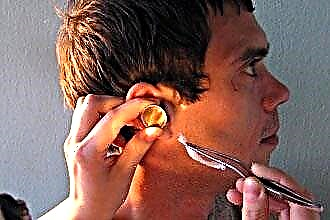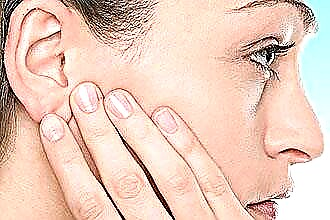Infectious and inflammatory lesions of the middle ear are a cause for alarm, regardless of the age of the patient. The danger associated with inflammatory changes is explained not only by the appearance of vivid symptoms and impaired well-being, but also by the high probability of the infection spreading, primarily to nearby organs. The inflammatory process in the middle ear often causes complications, the development of which can significantly worsen the prognosis for recovery. There is a fairly large number of diseases of the middle ear, which explains the need for an otolaryngologist to examine the patient. However, it is helpful for every patient to have an understanding of the symptoms of otitis media and how otitis media is treated in adults.
Symptoms

Inflammation of the middle ear, which is treated by an otolaryngologist, is divided into the following types:
- catarrhal;
- serous;
- purulent.
Catarrhal inflammation of the mucous membrane of the middle ear is called tubo-otitis, or eustachitis. With a serous or purulent nature of the inflammation, serous or purulent otitis media is isolated, respectively. There is a possibility of a chronic course of otitis media. The form of the pathological process depends on how to treat inflammation of the middle ear, whether surgery is required for otitis media. The listed forms are not always considered separate pathologies and are more often considered as successive stages in the development of otitis media - in this case, the pre-perforative, perforative and reparative stages of the purulent process are also called.
Tubo-otitis is characterized by noise in the ear, sharp sudden pain, and ear congestion. Patients hear their own voice during a conversation - a phenomenon called autophony. The general condition, as a rule, remains unchanged. The pain may be mild, short-lived. With serous otitis media, autophony, a feeling of pressure, fullness of the ear, combined with the sound of "splashing" during head movements, persists. Hearing is impaired.
Otitis media, symptoms of which the patient notices, can be described in different ways depending on the form of the process. Purulent inflammation of the middle ear in acute course is accompanied by complaints of such manifestations as:
- earache;
- hearing impairment;
- fever.
 In addition to the listed signs, there are also symptoms of an acute respiratory infection - general weakness, nasal congestion, headache, sore throat. The presence of pain syndrome is characteristic of the preperforative stage; at the stage of perforation, pain and fever are significantly reduced, and the patient's well-being improves. Hearing is restored at the stage of repair.
In addition to the listed signs, there are also symptoms of an acute respiratory infection - general weakness, nasal congestion, headache, sore throat. The presence of pain syndrome is characteristic of the preperforative stage; at the stage of perforation, pain and fever are significantly reduced, and the patient's well-being improves. Hearing is restored at the stage of repair.
In chronic suppurative otitis media, the patient complains of noise in the ear, the presence of pathological discharge, hearing impairment.
During the period of exacerbation, pain of varying intensity occurs, and the amount of discharge increases. The body temperature rises, there is a headache, dizziness.
Symptoms of acute otitis media are often combined with signs of an acute respiratory infection of a viral or bacterial nature.
Treatment principles
The goal of otitis media treatment is to stop the inflammatory process and prevent possible complications. The choice of the method of surgical treatment depends on the type of pathology, stage and nature of the course, the general condition of the patient. Shunting of the tympanic cavity, paracentesis of the tympanic membrane and a number of other methods are used.
Treatment of acute otitis media differs from the methods used for chronic suppurative otitis media. If in the first case, conservative therapy may be sufficient for the patient to recover, in the second it is present, as a rule, as a preparation for surgical intervention. Early treatment of otitis media reduces the duration of therapy, the list of procedures, prescribed drugs.
Recommendations are also relevant:
- limiting physical activity;
- bed rest during fever;
- careful toilet of the ear;
- a sufficient amount of liquid (water, tea, compotes);
- refusal to blow your nose simultaneously with two nostrils.

The last point is important for both prevention and treatment of otitis media. If the patient blows his nose with effort and does not close one nostril, trying to free both of the mucus at once, the infection easily penetrates the auditory tube. Therefore, mucus should not be sucked in either. If a large amount of infected secretion accumulates, you should use a handkerchief (preferably disposable paper), gently cleaning each nostril in turn.
Treatment of middle ear inflammation with folk remedies, if the treatment prescribed by the doctor is abandoned, can lead to complications. To cure otitis media as quickly as possible, complex drug therapy is needed.
With purulent otitis media, you should not warm your ear with a heating pad - this significantly increases the likelihood of severe complications.
Classification of drugs
The drug therapy regimen may include the following drug options:
| Groups of drugs | Examples of drugs | Action of drugs |
| 1. Antibacterial | Amoxiclav, Augmentin | Antibacterial |
| 2. Antiseptics | Boric acid | Antibacterial, antimycotic |
| 3. Local anesthetics. | Lidocaine | Antipruritic, analgesic |
| 4. Non-steroidal anti-inflammatory drugs (NSAIDs) | Phenazone, Ibuprofen | Anti-inflammatory, pain reliever |
| 5. Decongestants | Naphazoline, Naphtizin, Otrivin | Vasoconstrictor, anti-congestive |
| 6. Glucocorticosteroids | Betamethasone | Anti-inflammatory, antipruritic, anti-allergic |
Medicines are prescribed in forms for systemic and local use.
Tablets for otitis media are used only in combination with topical agents.
Antibacterial agents
Antibiotic therapy is recommended in all cases of acute purulent otitis media. Sometimes you can find controversy regarding the need for systemic use of antibiotics, but experts agree that the adequate prescription of these drugs helps to reduce the likelihood of complications, including intracranial ones. The place of antibiotic therapy in the treatment of chronic suppurative otitis media in adults is also frequently discussed. Recognition was gained by topical forms, the effectiveness of which is not inferior to systemic drugs - with the exception of a severe course.
How to treat otitis media in adults if it is acute? For both acute and chronic course of the disease, the best way to choose an antibiotic is to conduct a bacteriological examination of the secretions. This allows you to determine the type of pathogen, choose the most suitable agent, taking into account antibiotic sensitivity. In practice, with the rapid progression of the process, therapy is chosen empirically and may include:
- penicillins (Ampicillin);
- cephalosporins (ceftriaxone);
- macrolides (Clarithromycin);
- fluoroquinolones (Moxifloxacin).
When deciding how to treat otitis media with antibiotics, you need to think about the method of administration of the drug. The drugs are available in tablet and injectable form, and can be prescribed as monotherapy or in combinations. After the start of treatment (after 24–48 hours), the effectiveness is assessed, if necessary, the agent is replaced.
How to treat otitis media in adults with chronic course? Therapy, as mentioned before, is performed with local agents. There are several ways of administration:
- drip;
- by electrophoresis;
- using turunda.

Macrolides, like fluoroquinolones, are considered backup drugs. It is necessary to start treatment of otitis media in adults with ampicillin, ampicillin in combination with clavulanic acid or another drug available at the time of starting therapy, belonging to the group of penicillins or cephalosporins. Reserve antibiotics are used when primary therapy is ineffective, allergies, disease recurrence, pathogen resistance.
In the chronic form, the already named groups of antibacterial drugs are used, however, fluoroquinolones are recognized as the most effective for topical use. It is one of the basic rules to treat otitis media as soon as possible after confirming the diagnosis.
You need to know how otitis media can not be treated. An undesirable appointment is:
- Tetracycline.
- Lincomycin.
- Gentamicin.
- Co-trimoxazole.
Antimicrobial therapy, even with systemic use, should be combined with topical agents.
NSAIDs, decongestants
Drugs belonging to the NSAID group have analgesic and anti-inflammatory effects. They are used in tablet form, are part of drops and ointments. Decongestants, or vasoconstrictor agents, help restore the main functions of the auditory tube: drainage and ventilation. When injected, the patient is better off lying with his head turned towards the lesion.
Thinking about how to treat otitis media, it is necessary to understand that both NSAIDs and decongestants are symptomatic drugs with a temporary effect. They cannot replace complete therapy.
Decongestants are addictive and should not be used for longer than a week.
Combined funds
Most drugs used topically in the form of drops are combinations of active ingredients. The composition may include:
- antibiotics;
- antiseptics;
- glucocorticosteroids;
- local anesthetics.
An example is Anauran, which contains, in addition to the neomycin aminoglycoside antibiotic, polymyxin B (polypeptide antibiotic) and lidocaine, which is a local anesthetic. Neomycin, as a broad-spectrum antibacterial drug, is effective against representatives of gram-positive and gram-negative flora, and Polymyxin B has an effect on gram-negative microorganisms. Lidocaine is intended to relieve pain and itching sensations.
The combination of drugs is convenient for the patient, as it reduces the number of manipulations. It is necessary to treat both acute and chronic middle ear inflammation immediately after the diagnosis of the disease.
Potentially ototoxic agents should not be used after tympanic membrane perforation.





